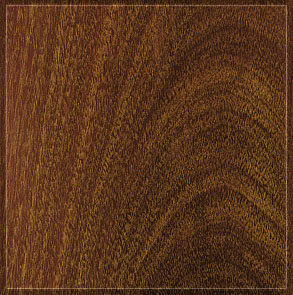Ipê
( Tabebuia )
Average Dried Weight: 69 lbs/ft 3 (1,100 kg/m 3 )
Specific Gravity (Basic, 12% MC): .91, 1.10
Janka Hardness: 3,510 lb f (15,620 N)
Modulus of Rupture: 25,660 lb f /in 2 (177.0 MPa)
Elastic Modulus: 3,200,000 lb f /in 2 (22.07 GPa)
Crushing Strength: 13,600 lb f /in 2 (93.8 MPa)
Shrinkage: Radial: 5.9%, Tangential: 7.2%, Volumetric: 12.4%, T/R
Ratio: 1.2
Color/Appearance: Heartwood can vary in color from reddish brown,
to a more yellowish olive brown or darker blackish brown; sometimes
with contrasting darker brown/black stripes. In certain species, there are
powdery yellow deposits within the wood. Ipe can be difficult to
distinguish visually from Cumaru , another dense South American timber,
though Ipe tends to be darker, and lacks the subtle yet characteristic
vanilla/cinnamon scent while being worked.
Grain/Texture: Has a fine to medium texture, with the grain varying
from straight to irregular or interlocked. Moderate natural luster.
Endgrain: Diffuse-porous; solitary and radial multiples; medium to
large pores in no specific arrangement, moderately numerous to
numerous; tyloses and mineral/gum deposits occasionally present;
parenchyma unilateral, winged, and marginal; narrow rays, spacing
normal; ripple marks present.
Rot Resistance: Rated as very durable; excellent insect resistance,
though some species are susceptible to marine borers. Superb weathering
characteristics. (Ipe was used for the boardwalk along the beach of New
York City’s Coney Island, and was said to have lasted 25 years before it
needed to be replaced: an amazing lifespan given the amount of traffic
and environmental stresses put upon the wood.)
Workability: Overall, Ipe is a difficult wood to work, being extremely
hard and dense, with high cutting resistance during sawing. Ipe also has a
pronounced blunting effect on cutting edges. The wood generally planes
smoothly, but the grain can tearout on interlocked areas. Also, Ipe can be
difficult to glue properly, and surface preparation prior to gluing is
recommended. Straight-grained wood turns well, though the natural
powdery yellow deposits can sometimes interfere with polishing or
finishing the wood.
Common Uses: Flooring, decking, exterior lumber, veneer, tool
handles, and other turned objects.
Useful info’s : Ipe is a wood of extremes: extremely dense and durable,
as well as extremely difficult to work. Its incredible hardness and strength
make it well suited for flooring applications, though it is referred to as
“Brazilian Walnut” among flooring dealers—though it is not related to
true Walnut in the Juglans genus.

